The DirectX 12 Performance Preview: AMD, NVIDIA, & Star Swarm
by Ryan Smith on February 6, 2015 2:00 PM EST- Posted in
- GPUs
- AMD
- Microsoft
- NVIDIA
- DirectX 12
DirectX 12 vs. Mantle, Power Consumption
Although the bulk of our coverage today is going to be focused on DirectX 12 versus DirectX 11, we also wanted to take a moment to also stop and look at DirectX 12 and how it compares to AMD’s Mantle. Mantle offers an interesting point of contrast being that it has been in beta longer than DirectX 12, but also due to the fact that it’s an even lower level API than DirectX 12. Since Mantle only needs to work on AMD’s GPUs and can be tweaked for AMD’s architectures, it offers AMD the chance to exploit their GPUs in a few additional ways that a common, cross-vendor API like DirectX 12 cannot.
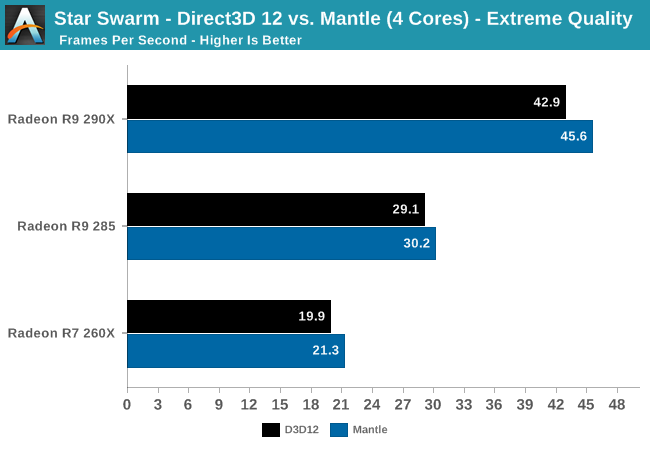
With 4 cores we find that AMD achieves better results with Mantle than DirectX 12 across the board. The gains are never very great – a few percent here and there – but they are consistent and just outside our window of variability for the Star Swarm benchmark. With such a small gain there are a number of factors that can possibly explain this outcome – better developed drivers, better developed application, further benefits of working with a known hardware platform – so we can’t credit any one factor. But it’s safe to say that at least in this one instance, at this time, Star Swarm’s Mantle rendering path produces even better results than its DirectX 12 path on AMD cards.
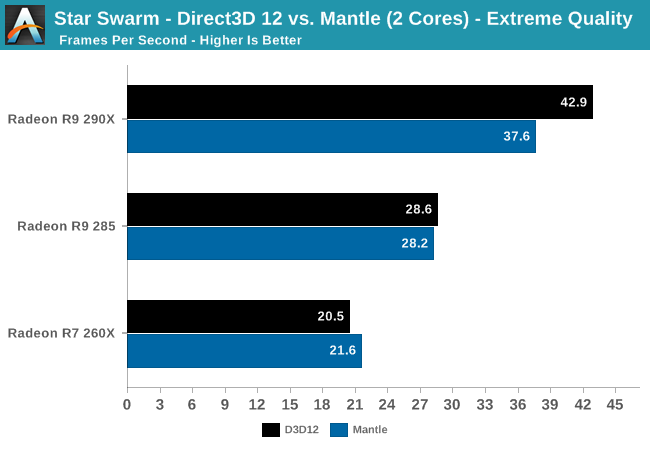
On the other hand, Mantle doesn’t seem to be able to accommodate a two-core situation as well, with the 290X seeing a small but distinct performance regression from switching to Mantle from DirectX 12. Though we didn’t have time to look at an AMD APU for this article, it would be interesting to see if this regression occurs on their 2M/4C parts as well as it does here; AMD is banking heavily on low-level APIs like Mantle to help level the CPU playing field with Intel, so if Mantle needs 4 CPU cores to fully spread its wings with faster cards, that might be a problem.

Diving deeper, we can see that part of the explanation for our Mantle performance regression may come from the batch submission process. DirectX 12 is unexpectedly well ahead of Mantle here, with batch submission taking on average a bit more than half as long as it does under Mantle. As batch submission times are highly correlated to CPU bottlenecking on Star Swarm, this would imply that DirectX 12 would bottleneck later than Mantle in this instance. That said, since we’re so strongly GPU-bound right now it’s not at all clear if either API would be CPU bottlenecked any time soon.
Update: Oxide Games has emailed us this evening with a bit more detail about what's going on under the hood, and why Mantle batch submission times are higher. When working with large numbers of very small batches, Star Swarm is capable of throwing enough work at the GPU such that the GPU's command processor becomes the bottleneck. For this reason the Mantle path includes an optimization routine for small batches (OptimizeSmallBatch=1), which trades GPU power for CPU power, doing a second pass on the batches in the CPU to combine some of them before submitting them to the GPU. This bypasses the command processor bottleneck, but it increases the amount of work the CPU needs to do (though note that in AMD's case, it's still several times faster than DX11).
This feature is enabled by default in our build, and by combining those small batches this is the likely reason that the Mantle path holds a slight performance edge over the DX12 path on our AMD cards. The tradeoff is that in a 2 core configuration, the extra CPU workload from the optimization pass is just enough to cause Star Swarm to start bottlenecking at the CPU again. For the time being this is a user-adjustable feature in Star Swarm, and Oxide notes that in any shipping game the small batch feature would likely be turned off by default on slower CPUs.
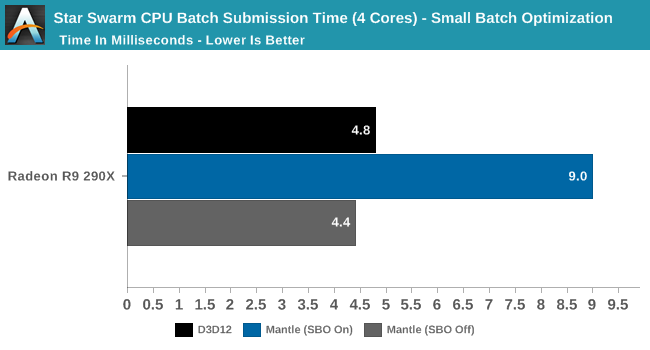
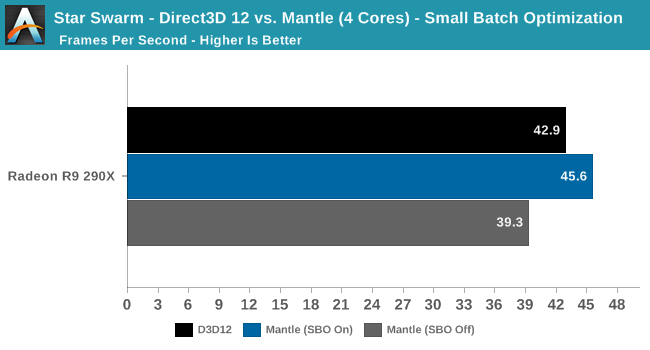
If we turn off the small batch optimization feature, what we find is that Mantle' s batch submission time drops nearly in half, to an average of 4.4ms. With the second pass removed, Mantle and DirectX 12 take roughly the same amount of time to submit batches in a single pass. However as Oxide noted, there is a performance hit; the Mantle rendering path's performance goes from being ahead of DirectX 12 to trailing it. So given sufficient CPU power to pay the price for batch optimization, it can have a signifcant impact (16%) on improving performance under Mantle.
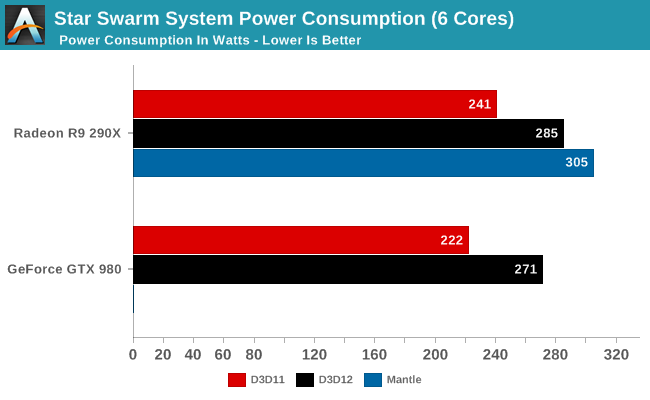
Finally, we wanted to take a quick look at power consumption among cards and APIs. To once again repeat what we said earlier, Star Swarm is an imperfect, non-deterministic benchmark, and coupled with the in-development status of DirectX 12 everything here is subject to change. However we thought this was interesting enough to include in our evaluation.
As expected, the increased throughput from DirectX 12 and Mantle drive up system power consumption. With the CPU no longer the bottleneck, the GPU never gets a chance to idle and video card power consumption ramps up to full load.










245 Comments
View All Comments
OrphanageExplosion - Tuesday, February 10, 2015 - link
Sony already has its low-level API, GNM, plus its DX11-a-like GNMX, for those who need faster results, easier debugging, handling of state etc.Gigaplex - Monday, February 9, 2015 - link
The consoles already use bare metal APIs. This will have minimal impact for consoles.Bill McGann - Tuesday, February 10, 2015 - link
D3D11.x is garbage compared to GNM (plus the XbOne HW is garbage compared to the PS4). The sad fact is that the XbOne desperately needs D3D12(.x) in order to catch up to the PS4.Notmyusualid - Monday, February 9, 2015 - link
Hello all... couldn't find any MULTI-GPU results...So here are mine:
System: M18x R2 3920XM (16GB RAM 1866MHz CAS10), Crossfire 7970Ms.
Test: Star Swarm Perf demo RTS, all Extreme setting.
Ambient temp 31C, skype idling in background, and with CPU ALL at stock settings:
Mantle: fps max 99.03 min 9.65 AVG 26.5
DX11: fps max 141.56 min 3.26 AVG 11.6
CPU at 4.4GHz x 4 cores, fans 100%, skype in background again:
Mantle: fps max 51.03 min 7.26 AVG 26.2 - max temp 94C
DX11: fps max 229.06 min 3.6 AVG 12.3 - max temp 104C + thus cpu throtteled at 23%.
So I guess there are good things coming to PC gamers with multi-gpu's then. Alas, being a mere mortal, I've no access to DX12 to play with...
Anyone care to offer some SLI results in return?
lamebot - Monday, February 9, 2015 - link
I have been reading this article page by page over the weekend, giving myself time to take it in. The frame times from each vendor under DX11 is very interesting. Thank you for a great, in depth article! This is what keeps me coming back.ChristTheGreat - Monday, February 9, 2015 - link
Can it be only a WIndows 10 Driver problem or optimisation for these result with the R9 290/X? On windows 8.1, 4770k 4.3ghz and R9 290 1100/1400, I do 40avg D3D11 and 66avg Mantle.. Scenario: follow, Detail: extreme...ChristTheGreat - Monday, February 9, 2015 - link
Oh well, I saw that you guys use the Asus PQ321, so running in 3 840 x 2 160?Wolfpup - Monday, February 9, 2015 - link
Good, can Mantle go away now? The idea of moving BACK to proprietary APIs is a terrible one, unless the only point of it was to push Microsoft to make these fixes in Direct X."Stardock is using the Nitrous engine for their forthcoming Star Control game"
I didn't know! This is freaking awesome news. I love love love Star Control 2 on the 3DO. Liked 1 on the Genesis too, but SC2 on the 3DO (which I think is better than the PC version) is not unlike Starflight-and somewhat like Mass Effect.
Wolfpup - Monday, February 9, 2015 - link
Forgot to mention... I also think AMD needs to worry about making sure their DirectX/Open GL drivers are flawless across years of hardware before wasting time on a proprietary API too...lordken - Monday, February 9, 2015 - link
Sorry but are you just amd hater or something?imho AMD did great thing with mantle and possibly pushed M$ to come with DX12 (or not we will never know). But that aside how about you think about some advantages mantle has?
I think that when they bring it to linux (they said they would, not sure about current status) that will be nice advantage as I guess native api would work better than wine etc. With more recent games (thanks to new engines) comming to linux would probably benefit more if they would run on mantle.
And nonetheless how about ppl that wont move to Win10 (for whatever reason)? Mantle on Win7/8 would still be huge benefit for such ppl. Not to mention that there will be probably more games with mantle than with DX12 in very close feature.
Plus if they work out console & pc mantle aspect it could bring better console ports to PC, even if game devs would be lazy to do proper optimalization mantle should pretty much eliminate this aspect (though only for amd gpu).
But either way I dont see much reason why should mantle go. I mean once it is included in all/most bigger engines (already in cryengine,frostbite,unreal) and it works what reason would be to trash something that is usefull?
btw funny how "M$ would need to do huge kernel rework to bring DX12 to Win7/8" while mantle, which does similar thing, is easily capable to be "OS version independent" (sure it is amd specific but still)
PS:What about amd drivers? They are fine imho, never had problem in last years. (you see personal experience is not a valid argument)